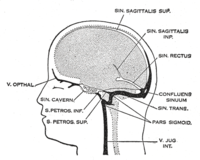
Photo from wikipedia
Cerebral venous thrombosis (CVT) mostly affects young people. So far, endovascular treatment (EVT) has not been shown to be beneficial in CVT, partially because venous EVT tools are not yet… Click to show full abstract
Cerebral venous thrombosis (CVT) mostly affects young people. So far, endovascular treatment (EVT) has not been shown to be beneficial in CVT, partially because venous EVT tools are not yet fully optimized, and therefore EVT is only used as a rescue treatment in rare cases. Identifying a subgroup of CVT patients that could benefit from EVT is challenging, given the milder course of disease compared with acute ischemic stroke, the paucity of data on prognostic factors (both in the clinical and imaging domain), and the lack of consensus on what constitutes 'technical success' in CVT EVT. In this review, we discuss the major obstacles that are encountered when trying to identify CVT patients that may benefit from EVT, and propose a roadmap that could help to overcome these challenges in the near future.
Journal Title: Journal of NeuroInterventional Surgery
Year Published: 2022
Link to full text (if available)
Share on Social Media: Sign Up to like & get
recommendations!